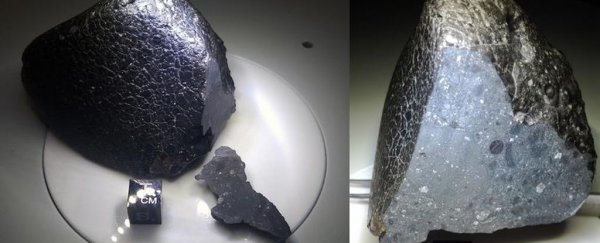Evidence for an intense asteroid impact on Mars has been found in a Martian meteorite, which could alter the timeline for when the red planet might have been habitable.
In a famous meteorite named NWA 7034, or 'Black Beauty', scientists discovered a shocked crystal of the mineral zircon, showing a feature only seen on Earth in massive impact craters. This suggests that Mars was under heavy bombardment from meteorites later than thought.
"This grain is truly a one-off gift from the Red Planet," says planetary geologist Morgan Cox of Curtin University in Australia.
"High-pressure shock deformation has not previously been found in any minerals from Black Beauty. This discovery of shock damage in a 4.45 billion-year-old Martian zircon provides new evidence of dynamic processes that affected the surface of early Mars."
NWA 7034, discovered in 2011 in the Sahara Desert of Morocco, is a 320-gram (11.3-ounce) chunk of volcanic breccia. That is, it's composed of pieces of different types of rock, a bit like a fruit cake.
It's mostly basalt, but it's scattered through with inclusions, including a number of crystals of zircon, and parts of it are up to 4.45 billion years old, nearly as old as the planet itself.
The early Solar System was a much wilder place than it is today. We've found evidence that, early on, the inner planets were absolutely pummeled by large asteroid impacts.
The overall absence of shock damage in the zircons from NWA 7034 was previously given as evidence that this intense period of bombardment on Mars had declined by about 4.48 billion years ago. Consequently, this could have meant that Mars was habitable quite early on.
Cox and her colleagues followed up by performing a close study of 66 grains of zircon found in NWA 7034, performing electron backscatter diffraction mapping and cathodoluminescence imaging to probe the structural arrangement of the atomic lattice within.
In just one of the 66 grains, one that was 4.45 billion years old, the team identified evidence of a massive impact.
"The type of shock damage in the Martian zircon involves 'twinning', and has been reported from all of the biggest impact sites on Earth, including the one in Mexico that killed off the dinosaurs, as well as the Moon, but not previously from Mars," Cox said.
In all minerals, atoms are arranged in a symmetrical three-dimensional lattice structure. Think of, for example, a lattice cube, where an atom sits at each corner of every cube in the lattice (although the actual structure varies significantly from mineral to mineral).
When high enough pressure is applied – 20 to 30 gigapascals, such as we see in the biggest asteroid impacts – something strange can happen to these lattices. Crystals can be pushed together so tightly that they end up sharing some of the points on their crystal lattices.
Although the team only found twinning in one of their zircon crystals, that one crystal suggests a formation process similar to what we have seen here on Earth, involving high pressure, likely from an asteroid impact. This, the researchers said, suggests that heavy bombardment on Mars was occurring at least 30 million years after the previous estimate.
In turn, this suggests that conditions may not have been amenable for life until a bit later, too – which coincides with the Mars timeline for another condition for life as we know it, the researchers say.
"Prior studies of zircon in Martian meteorites proposed that conditions suitable for life may have existed by 4.2 billion years ago based on the absence of definitive shock damage," says planetary geologist and geochemist Aaron Cavosie of Curtin University.
"Mars remained subject to impact bombardment after this time, on the scale known to cause mass extinctions on Earth. The zircon we describe provides evidence of such impacts, and highlights the possibility that the habitability window may have occurred later than previously thought, perhaps coinciding with evidence for liquid water on Mars by 3.9 to 3.7 billion years ago."
Given that prolonged heavy asteroid bombardment would have had the potential to vaporize any surface water and disrupt the atmosphere, though, perhaps that's not such a coincidence after all.
The research has been published in Science Advances.
